Hildesheim
Hildesheim [ˈhɪldəsˌhaɪ̯m] (![]()
Hildesheim | |
|---|---|
    _2.jpg) 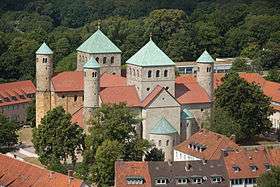 View over Hildesheim, St. Mary's Cathedral (UNESCO World Heritage Site), Historic Market Place, half-timbered houses at the Brühl street, Roemer- und Pelizaeus-Museum, St. Maurice Church on the Moritzberg, St. Michael's Church (UNESCO World Heritage Site) | |
 Coat of arms | |
Location of Hildesheim within Hildesheim district 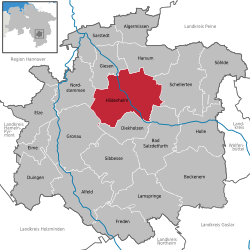 | |
 Hildesheim 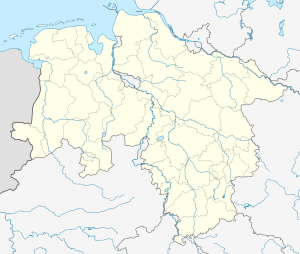 Hildesheim | |
| Coordinates: 52°09′N 09°57′E | |
| Country | Germany |
| State | Lower Saxony |
| District | Hildesheim |
| Government | |
| • Mayor | Ingo Meyer |
| Area | |
| • Total | 92.96 km2 (35.89 sq mi) |
| Elevation | 78 m (256 ft) |
| Population (2018-12-31)[1] | |
| • Total | 101,990 |
| • Density | 1,100/km2 (2,800/sq mi) |
| Time zone | CET/CEST (UTC+1/+2) |
| Postal codes | 31101–31134 |
| Dialling codes | 05121 |
| Vehicle registration | HI, ALF |
| Website | www.hildesheim.de |
| UNESCO World Heritage Site | |
|---|---|
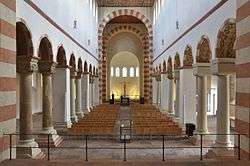 Ottonian architecture in St. Michael's Church | |
| Criteria | Cultural: i, ii, iii |
| Reference | 187 |
| Inscription | 1987 (11th session) |
| Area | 0.58 ha |
| Buffer zone | 157.68 ha |
The Holy Roman Emperor Louis the Pious founded the Bishopric of Hildesheim in 815 and created the first settlement with a chapel on the so called Domhügel.
Hildesheim is situated on autobahn route 7, and hence is at the connection point of the North (Hamburg and beyond) with the South of Europe.
With the Hildesheim Cathedral and the St. Michael's Church, Hildesheim became a UNESCO World Heritage site in 1985.
In 2015 the city and the diocese celebrated their 1200th anniversary.
History
Early years

Hildesheim, one of the oldest cities in Northern Germany, became the seat of the Bishopric of Hildesheim in 815 and may have been founded when the bishop moved from Elze to the ford across the River Innerste, which was an important market on the Hellweg trade route. The settlement around the cathedral very quickly developed into a town and was granted market rights by King Otto III in 983.[3] Originally the market was held in a street called Alter Markt (Old Market) which still exists today. The first market place was laid out around the church St. Andreas. When the city grew further, a larger market place became necessary. The present market place of Hildesheim was laid out at the beginning of the 13th century when the city had about 5,000 inhabitants.
Middle ages
When Hildesheim obtained city status in 1249, it was one of the biggest cities in Northern Germany.[4] For four centuries the clergy ruled Hildesheim, before a town Hall was built and the citizens gained some influence and independence. Construction of the present Town Hall started in 1268.[5] In 1367 Hildesheim became a member of the Hanseatic League. A war between the citizens and their bishop cost dearly in 1519–23 when they engaged in a feud.
Reformation
Hildesheim became Lutheran in 1542, and only the cathedral and a few other buildings remained in Imperial (Roman Catholic) hands. Several villages around the city remained Roman Catholic as well.
19th century
In 1813, after the Napoleonic Wars, the town became part of the Kingdom of Hanover, which was annexed by the Kingdom of Prussia as a province after the Austro-Prussian War in 1866. In 1868 a highly valuable trove of about 70 Roman silver vessels for eating and drinking, the so-called Hildesheim Treasure, was unearthed by Prussian soldiers.
Early 20th century and World War II
The city was heavily damaged by air raids in 1945, especially on 22 March. Although it had little military significance, two months before the end of the war in Europe the historic city was bombed as part of the Area Bombing Directive in order to undermine the morale of the German people. 28.5% of the houses were completely destroyed and 44.7% damaged. 26.8% of the houses remained undamaged. The centre, which had retained its medieval character until then, was almost levelled. The city as a whole was destroyed by 20 - 30%.[6] As in many cities, priority was given to rapid building of badly needed housing, and concrete structures took the place of the destroyed buildings. Most of the major churches, two of them now UNESCO World Heritage Sites, were rebuilt in the original style soon after the war. During the war, valuable world heritage materials had been hidden in the basement of the city wall.
Late 20th century and present
In 1978, the University of Hildesheim was founded. In the 1980s a reconstruction of the historic centre began. Some of the unattractive concrete buildings around the market place were torn down and replaced by replicas of the original buildings. In the autumn of 2007, a decision was made to reconstruct the Umgestülpter Zuckerhut (Upended Sugarloaf), an iconic half-timbered house famous for its unusual shape. In 2015 the city and the diocese celebrates their 1200 anniversary with the Day of Lower Saxony.
Religions
In 1542 most of the inhabitants became Lutherans. Today, 28.5% of the inhabitants identify themselves as Roman Catholics (Hildesheim Diocese) and 38.3% as Protestants (Evangelical Lutheran Church of Hanover). 33.0% of the inhabitants are adherents of other religions or do not have a religion at all. The Serbian Orthodox Bishop of Frankfurt and all of Germany has his seat in Himmelsthür (a locality of Hildesheim).
Main sights





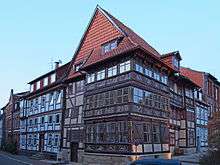
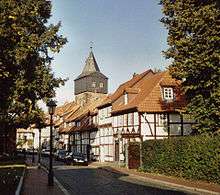

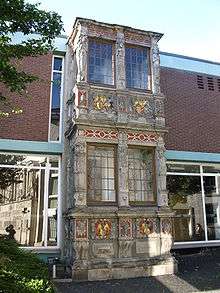



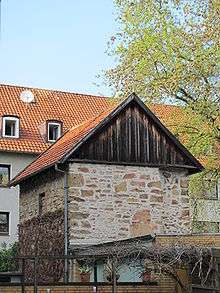
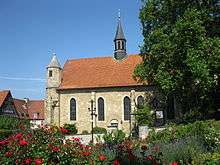

- The Marktplatz (historic market place) was reconstructed in 1984–1990 after its destruction in the March 1945 air raid. The more noteworthy buildings in the square are:
- The Knochenhaueramtshaus (Butchers' Guild Hall), originally built in 1529 and destroyed in 1945, it was reconstructed from 1987 to 1989 according to original plans. The façade is sumptuously decorated with colourful paintings and German proverbs. Today the building houses a restaurant and the City Museum.
- The Bäckeramtshaus (Bakers' Guild Hall) is a half-timbered house which was originally built in 1825. It was destroyed in 1945 and rebuilt 1987-89. Today, it houses a café.
- The Town Hall, erected in the 13th century in Gothic style. Partly destroyed in 1945, it was rebuilt and inaugurated in 1954.
- The Tempelhaus, a late-Gothic 14th-century patrician house, which today houses the tourist information office. It suffered some damage during the Second World War but was restored and inaugurated in 1950.
- The Wedekindhaus, a 16th-century patrician house, is characterised by its high, ornately carved storeys including their ledges with depictions of allegorical figures.
- The adjoining Lüntzelhaus was built in 1755 in Baroque style.
- The Rolandhaus was originally built in the 14th century in Gothic style. In 1730, the house was remodelled, and a Baroque portal and a large bay window were added.
- The Stadtschänke (Town Tavern) is a large half-timbered house which was originally built in 1666. The smaller adjoining Rococcohaus was built in 1730 in rococo style.
- The Wollenwebergildehaus (Weavers' Guild Hall) was approximately built in 1600.
- The Romanesque St. Mary's Cathedral (Hildesheim Cathedral), with its ancient bronze doors (Bernward Doors) (c. 1015) and other treasures. The cathedral was built in the 9th century, but almost completely destroyed in 1945; it was reconstructed soon after the war. It has been listed as a UNESCO World Heritage Site since 1985. The "Thousand-year Rose" is a reputedly 1,000‑year‑old dog rose bush, allegedly the world's oldest living rose. It continues to flourish on the wall of the cathedral apse.
- Museum of the Cathedral: Cathedral Treasure.
- St. Michael's Church (UNESCO World Heritage Site) – an early Romanesque church in Germany and an example of Ottonian architecture. It was built from 1010 to 1022.
- The St. Andreas (St. Andrew's Church), a 12th-century Gothic church with the highest church steeple (114.5 m) in Lower Saxony. Opposite the church stands the Upended Sugarloaf, a half-timbered house dating from 1509.
- The Roemer-und-Pelizaeus-Museum, with collections from ancient Egypt and Peru and special exhibitions.
- The Kreuzkirche (Church of the Holy Cross) was originally a part of the medieval fortifications. It was converted into a church around 1079, severely damaged in 1945 and rebuilt after the war.
- The Romanesque Basilica Minor of St. Godehard (St. Gotthard's Church), built 1133–1172, which is scheduled to become a UNESCO World Heritage Site in the near future. Other notable buildings stand opposite the church: St. Nicolai's Chapel is a former parish church which was built in the Romanesque style in the 12th century and transformed into a residential building after 1803, and the Hospital of the Five Wounds which is a large half-timbered house dating from 1770 with a half-hip roof.
- The church St. Lamberti is a late Gothic building, venue of a weekly concert series at market time.
- The Kehrwiederturm (Kehrwieder Tower), built around 1300, is the only remaining tower of the medieval fortifications.
- Half-timbered houses which were not destroyed during World War II can be seen around St. Godehard and the Kehrwieder Tower, in the streets Keßlerstraße, Knollenstraße, Gelber Stern, Am Kehrwieder, Lappenberg, Brühl, Hinterer Brühl, and Godehardsplatz. Some of them have ornate wood carvings in their façades, e.g. the Wernersches Haus (1606) in Godehardsplatz and the Waffenschmiedehaus (weapon smith house, 1548) at Gelber Stern.
- The church St. Jacobi (St. James' Church) is a 500-year-old pilgrim church in the Gothic style and was one of the many St. James chapels on St. James's Path. Today the church is a culture church with emphasis on literature.
- The Monument of the Synagogue (consecrated in 1849 and destroyed in 1938 during the Kristallnacht) was erected in 1988 in the old Jewish quarter on Lappenberg Street. The foundations were reconstructed to give observers an idea of how large the synagogue was. The reddish brick building (built around 1840) opposite was the Jewish school.
- Mauritiuskirche (St. Maurice's Church), a Romanesque church (11th century) on a hill in the west of the city in the quarter of Moritzberg with a cloister. The interior of the church is Baroque and the tower was added in 1765.
- Kaiserhaus (Emperor's House): Renaissance building (1586) in Alter Markt, the oldest street of Hildesheim, rebuilt after the war. The façade is decorated with Roman statues and medallions. Opposite, there is a noteworthy sandstone bay window dating from 1568. Originally, it belonged to a private house which was torn down at the end of the 19th century. The bay window was dismantled before and added to another house in the eastern part of Hildesheim which remained undamaged during World War II. From there, the bay window was removed when the house was remodelled and added to the school at the present site in 1972.[7]
- Close to the Kaiserhaus (Emperor's house) the Alte Kemenate, a noteworthy medieval store house reaching a height of 5.5 meters, can be seen behind the school in the street Alter Markt. It has a rectangular basis measuring 6.5 meters × 5.0 meters and a cellar with a vaulted construction.[8] The store house, one of the oldest profane buildings in Hildesheim, was built of sandstone in a Gothic style the 15th century. According to other sources it might be even older, i.e. built between the end of the 11th and the middle of the 13th century.[9] The building has two floors. As it did not consist of wood it did not burn down in 1945, but was only damaged and immediately repaired after the war. From 1945 - 1951 it was used for residential purposes. The Alte Kemenate is not open to the public.
- St. Magdalena's Church (Magdalenenkirche) is a small church with large lancet windows in the historic street Old Market (Alter Markt) which was consecrated in 1224. It was originally built in a Romanesque style, but enlarged and remodelled in Gothic style in 1456. It houses a wooden altar (about 1520) with carvings and other works of art. The small street Süsternstraße features a well-preserved part of the medieval city wall with a round tower. Opposite the church, a tall half-timbered house which was rebuilt in 1981 on the medieval city wall can be seen in the small side street Mühlenstraße. The façade is decorated with wood carvings.
- Magdalenengarten, a Baroque park which was laid out in 1720–1725, is near St. Magdalena's Church. There are many different kinds of rose bushes, a rose museum, pavilions, Baroque statues, a well-preserved part of the medieval city wall in it and even a vineyard yielding 100–200 bottles of wine per year. In spring, a rare species of wild yellow tulips (tulipa sylvestris) blossoms in the western part of the park.
- St. Bernward's Church, a neo-Romanesque church built 1905–1907, destroyed in 1945 and rebuilt from 1948 to 1949, houses a Gothic wooden altar retable dating from the beginning of the 15th century.
- A part of the medieval defence system consisting of a wall with moats and ramparts which was built around the city in the 13th century is well preserved. Kalenberger Graben, an artificial lake, is a part of it. It is surrounded by a park. In April a rare species of wilde yellow tulips (tulipa sylvestris) blossoms in the park.
- Steuerwald Castle (Burg Steuerwald) in the north of the city, about 3 km (2 mi) from the Market Place, was built 1310–13. Its tower (25 m) was added in 1325. The chapel, dedicated to St Magdalena, was originally built in the Romanesque style and transformed into a Gothic chapel in 1507. Today it is used for weddings and concerts.
- Marienburg Castle (Burg Marienburg) is in the southeast of Hildesheim, about 6 km (4 mi) from the Market Place. It was built 1346–1349.
- Sorsum is a former village in the West of Hildesheim which became a part of the city in 1974. There is a former domain, founded in the Middle Ages, which was transformed into a residential area after 2000. The pigeon tower, built in 1733, the large barn (1786) and the manor house dating from 1734 are the most notable sights in this rural part of Hildesheim.
- Marienrode Priory (Kloster Marienrode) is in the southwest of Hildesheim, about 6 km (4 mi) from the Market Place. It was founded in 1125. The foundation stone of the present church was laid in 1412. The church was built in Gothic style with three naves and completed in 1462. The Baroque ridge turret was added in the 18th century. In the church, there are two noteworthy Baroque altars dating from 1750 approximately and a Gothic sandstone sculpture of Saint Mary which was made in 1460. The organ dates from the middle of the 18th century. A small chapel of the priory, Saint Cosmas and Damian, which was built in 1792, was converted into a small Protestant church in 1830. The priory was dissolved in 1806, but returned to the Catholic Church in 1986. Since 1988, it has again been operated by nuns. Near the monastery there is a large fishpond with a tall windmill built in 1839.
Other places of interest include the theatre, offering opera, operetta and musicals, drama, ballet and concerts.
Incorporations
- 1911: Moritzberg
- 1912: Steuerwald
- 1938: Drispenstedt and Neuhof
- 1971: Ochtersum
- 1974: Achtum-Uppen, Bavenstedt, Einum, Himmelsthür, Itzum, Marienburg, Marienrode and Sorsum
Demographics
Population history
On 31 Dec 2017 Hildesheim had 103,970 inhabitants.[10]
| Year | Pop. | ±% |
|---|---|---|
| 1400 | 6,000 | — |
| 1450 | 8,000 | +33.3% |
| 1648 | 5,500 | −31.2% |
| 1803 | 11,108 | +102.0% |
| 1825 | 12,630 | +13.7% |
| 1849 | 14,651 | +16.0% |
| 1871 | 20,801 | +42.0% |
| 1875 | 22,581 | +8.6% |
| 1890 | 33,481 | +48.3% |
| 1900 | 42,973 | +28.4% |
| 1910 | 50,239 | +16.9% |
| 1919 | 53,499 | +6.5% |
| 1925 | 58,522 | +9.4% |
| 1933 | 62,519 | +6.8% |
| 1939 | 72,101 | +15.3% |
| 1950 | 65,531 | −9.1% |
| 1961 | 96,296 | +46.9% |
| 1970 | 93,400 | −3.0% |
| 1975 | 106,000 | +13.5% |
| 1980 | 102,700 | −3.1% |
| 1985 | 100,900 | −1.8% |
| 1989 | 103,512 | +2.6% |
| 1997 | 105,700 | +2.1% |
| 2002 | 103,448 | −2.1% |
| 2013 | 100,708 | −2.6% |
| 2015 | 101,667 | +1.0% |
| 2017 | 103,970 | +2.3% |
List of mayors of Hildesheim
- 1803–1843: Georg Otto Ferdinand Lohde
- 1843–1848: Carl Christoph Lüntzel
- 1848: Commissioned by Oberg, Starke, and Wynecken
- 1848–1852: Amtsassessor Domeier
- 1853–1875: Paul Johann Friedrich Boysen
- 1876–1895: Gustav Struckmann
- 1895–1896: Hans Ukert, not as mayor
- 1896–1909: Gustav Struckmann, reelected
- 1909–1937: Ernst Ehrlicher
- 1945–1946: Erich Bruschke
- 1946–1950: Albin Hunger
- 1950–1952: Friedrich Lekve
- 1952–1958: Albin Hunger, reelected
- 1958–1959: Paul Lienke
- 1959–1964: Martin Boyken
- 1964–1968: Friedrich Nämsch
- 1968–1972: Martin Boyken, reelected
- 1972–1975: Friedrich Nämsch, reelected
- 1975–1981: Heiko Klinge
- 1981–1991: Gerold Klemke
- 1991–2001: Kurt Machens
- 2001–2005: Dr. Ulrich Kumme
- 2005–2014: Kurt Machens, reelected
- 2014–present: Dr. Ingo Meyer
International relations
Twin towns – sister cities
Hildesheim is twinned with:[12]






Other forms of cooperation
Events of international interest
- M'era Luna Festival, Europe's most important event of the gothic and wave scene
- "Jazztime" festival on the weekend of Pentecost (in May or June)
Economy
Hildesheim is home to notable multinational corporations – besides many strong medium-sized companies – including Blaupunkt, Bosch, Krupp, Thyssen, Fairchild and Coca-Cola.
Transport
Hildesheim has an efficient traffic infrastructure: it is a regional hub for interstate roads and railway (Hildesheim Hauptbahnhof is served by InterCityExpress services), is connected to the motorway (Autobahn), has a harbour at the artificial waterway Mittellandkanal and Hildesheim Betriebsgesellschaft Airfield.
Culture
The community has the headquarters of the Serbian Orthodox Eparchy of Frankfurt and all of Germany.[13]
Notable residents
A–K


- Klaus Berger, (born 1940), ev. theologian
- St. Bernward, (960–1022), bishop of Hildesheim
- Adolf Bertram (1859-1945), German Roman Catholic bishop
- Andreas Bovenschulte (born 1965), politician
- Ludolph van Ceulen, (1540–1610), mathematician
- Nadine Chanz, (born 1972), playboy playmate
- Bernd Clüver, (1948–2011), crooner (The boy with the harmonica)
- Wolfgang Danne, (born 1941), figure skater
- Catharina Helena Dörrien, (1717-1795), botanist
- Saint Godehard, (960–1038), also known as St. Gotthard, Bishop of Hildesheim
- Uwe Gronostay, (1939–2008), choirmaster
- Jakob Guttmann (1845–1919), chief rabbi, philosopher, pedagogue
- John of Hildesheim (1310/1320–75), a writer and Carmelite friar
- Julius Guttmann (1880–1950), German and Israeli rabbi, Jewish philosopher and historian
- Karl Hamann, (1903–73), 1948–51 chairman of the LDPD and minister
- Prince Ernst August of Hanover (born 1983), born in Hildesheim.
- Petra Hartmann, (born 1970), author and literature scientist
- Hubertus Heil (born 1972), politician (SPD)
- Wilhelm Hennis, (1923–2012), political scientist
- Frederick Hornemann, (1772–1801), German African explorer
- Adolf Hurwitz, (1859–1919), 19th-century German mathematician
- Wilhelm Koppe, (1896–1975), 20th-century German Obergruppenführer and General der Waffen-SS und Polizei
- Hans Adolf Krebs, (1900–81), physician and biochemist, Physiology and Medicine in 1953
- Diane Kruger, (born 1976), supermodel and actress, who played in Troy
L–Z
- Heinrich Nordhoff (1899–1968), engineer, Chairman of Volkswagen and key figure on the VW Beetle's history.
- Didrik Pining, (1430–91), a 15th-century explorer of the North Atlantic, was born in Hildesheim.

- Erich Pommer (1889–1966), film producer, born in Hildesheim.
- Thomas Quasthoff, (born 1959), German bass-baritone singer
- Henry Rathbone, (1837–1911), US Consul, institutionalized in Hildesheim after murdering his wife by acquitted by reason of insanity.
- Ferdinand von Roemer, (1818–91), geologist, born in Hildesheim.
- Michael Schenker, (born 1955), German rock guitarist, founding member of the Scorpions and of the band UFO
- Rudolf Schenker, (born 1948), guitarist and founding member of the hard rock band Scorpions, born in Hildesheim.
- Oskar Schindler (1908–74) German industrialist, Righteous Among the Nations, died in Hildesheim, see also the movie Schindler's List
- Eberhard Schlotter, (1921–2014), painter and graphic artist
- Wolfram Sievers, (1905–48), Nazi war criminal and director of Ahnenerbe, executed for war crimes
- Bruno Snell, (1886–1986), classic philologist
- Guy Stern, (born 1922), American literary critic and honorary citizen of the city
- Maik Taylor, (born 1971), Northern Ireland and Birmingham City footballer.
- The twins Wolfgang and Christoph Lauenstein, (born 1962), winners of an Academy Award in 1989 for their film Balance.
- Wilhelm Wachsmuth (1784-1866), historian
Gallery
 Spheric Panorama of the Market Place
Spheric Panorama of the Market Place Knochenhaueramtshaus before the destruction on 22 March 1945
Knochenhaueramtshaus before the destruction on 22 March 1945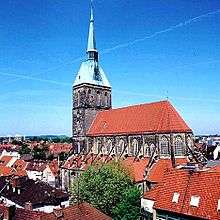 St. Andreas, 114 m high steeple
St. Andreas, 114 m high steeple Basilica St. Godehard
Basilica St. Godehard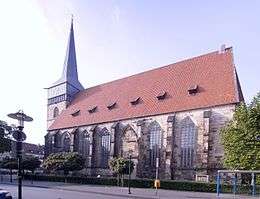 St. Lamberti, 2007, with the new spire
St. Lamberti, 2007, with the new spire Market Place (Markt) on an autumn evening
Market Place (Markt) on an autumn evening St. Mauritius Church.
St. Mauritius Church. Half-timbered houses in Keßlerstraße.
Half-timbered houses in Keßlerstraße.- Half-timbered houses in street "Hinterer Brühl"
- Abbey of the Dormition of the Theotokos, former seat of the Serbian Orthodox Eparchy of Frankfurt and all of Germany.
 The town hall around 1900
The town hall around 1900
See also
- Metropolitan region Hannover-Braunschweig-Göttingen-Wolfsburg
References
- Landesamt für Statistik Niedersachsen, LSN-Online Regionaldatenbank, Tabelle 12411: Fortschreibung des Bevölkerungsstandes, Stand 31. Dezember 2018.
- https://www.hildesheim.de/pics/verwaltung/1_1549983673/Bevoelkerung_der_Stadt_Hildesheim_HW_31.12.2018.pdf
- Neigenfind, W.: Unsere schöne Stadt, p.46. Hildesheim 1964.
- Neigenfind, W.: Unsere schöne Stadt, p.38. Hildesheim 1964.
- Borck, Heinz-Günther: Der Marktplatz zu Hildesheim, p.24. Hildesheim 1989.
- http://archiv.nationalatlas.de/wp-content/art_pdf/Band5_88-91_archiv.pdf
- Segers-Glocke, Christiane: Baudenkmale in Niedersachsen, Band 14.1. - Hildesheim, p.109. Hameln 2007.
- Segers-Glocke, Christiane: Baudenkmale in Niedersachsen, Band 14.1. - Hildesheim, p.108. Hameln 2007.
- Stadtgeschichte auf dem Hinterhof. - Hildesheimer Allgemeine Zeitung, 23 June 2009, p.9.
- "Fläche und Bevölkerung".
- "Stadt Hildesheim Statistische Daten 2014" (PDF). Stadt Hildesheim. Retrieved 2015-07-13.
- "Partnerstädte". hildesheim.de (in German). Hildesheim. Retrieved 2019-11-29.
- "Kontakdaten Archived 2012-03-10 at the Wayback Machine." Diocese of Central Europe. Retrieved on 27 February 2011. "Obere Dorfstr. 12 D - 31137 Hildesheim-Himmelsthür"
External links
| Wikimedia Commons has media related to Hildesheim. |
| Wikivoyage has a travel guide for Hildesheim. |
